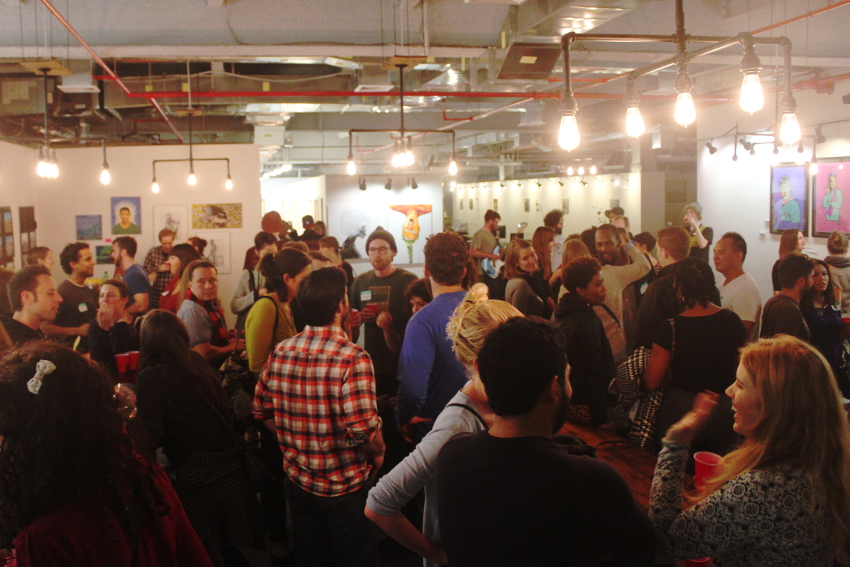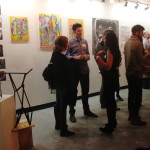RPCV Artists in NYC

I heard recently from Dan Ingala, Public Affairs Specialist at the Peace Corps Northeast Office in New York, about the Peace Corps Art Show that has been organized for the last three years by the Returned Peace Corps Volunteers of New York. Dan connected me to Sarah Porter (Macedonia 2005-07) president of the group and vice president Nicole Ethier (Indonesia 2011-13)
Sarah wrote me in an email that the show started in Brooklyn at the co-working space called BrooklynWorks 159, saying, “Some of the art is based on or shaped by the Peace Corps experience – there have been several pieces that were made during the volunteer’s experience – but many pieces are independent of that.”
BrooklynWork 159 is owned by an RPCV, Vic Puri (Samoa 2002-04), and as Sarah says, “it is not only beautiful and conducive to becoming an art gallery for an evening, having the exhibition at an RPCV-owned space makes the show even more meaningful.”

This is the third year of the exhibition at BrooklynWork 159 and as Sarah points out, “RPCVs have had such a unique experience living outside their country and culture. But in addition to this, many of us also happen to be artists. Whether it’s as a profession, a hobby, or an expression we want to be able to highlight and show another side to RPCVs.”
Since the first year, the RPCV group in NYU has been hearing from other New York RPCVs who are not part of the group, but heard about the show and wanted to attend the event.
As Sarah sums up, “Just like humans in general, we all come from very different walks of life yet are brought together by common experiences. It’s a wide spectrum, but it’s so interesting to see all these very different people, who have varied styles, create such individual and personal forms of art. We are then reminded that we all share this one thing. I like that if someone just walked into the show from off the street, they would have no idea that we were all Peace Corps volunteers. I think it would be similar to wandering in to a gallery in Manhattan; you are there to admire works of art and to appreciate and consider what the artist is communicating.”
While this art show was on in Brooklyn, across the river in Manhattan, at the Morgan Library and Gallery, the works of another RPCV was on display.
Martin Puryear (Sierra Leone 1964-66) was born in Washington, DC and studied crafts as a kid and learned how to build guitars, furniture, and canoes. After earning his BA from Catholic University in Washington DC, he joined the Peace Corps and went to Sierra Leone where he taught English, French, biology, and art. The experience, I gather, both dampened and strengthened Puryear’s sense of his African roots. The local villagers, he found, thought of him as a foreigner despite his black skin. “The name for me was the same as for Europeans,” he told the New York Times. “They had a word, pronounced ‘pumwei,’ which meant European or foreigner or white man. It was very clear to me that I wasn’t one of them.” Yet Puryear was influenced enormously by his encounters with African carpenters, who forged complicated objects without the help of mechanical technology. And the graceful forms of African sculpture left a permanent imprint on Puryear’s work. By the time he left Sierra Leone, Puryear was determined to be a sculptor.
Europeans,” he told the New York Times. “They had a word, pronounced ‘pumwei,’ which meant European or foreigner or white man. It was very clear to me that I wasn’t one of them.” Yet Puryear was influenced enormously by his encounters with African carpenters, who forged complicated objects without the help of mechanical technology. And the graceful forms of African sculpture left a permanent imprint on Puryear’s work. By the time he left Sierra Leone, Puryear was determined to be a sculptor.
His show at the Morgan, the brochure says, “creates work that combines the clean elegance of minimalism and the simplicity of traditional materials. His sculptures explore themes of identity, ethnicity, and history, and are rich with social and cultural commentary. Puryear, who is known for abstract, large-scale pieces in wood, stone, and bronze, has captured the attention of the art world for the past 30 years. Despite the apparent simplicity of his works, however, he engages in an extensive iterative process that has, until now, been unknown.”
No comments yet.
Add your comment